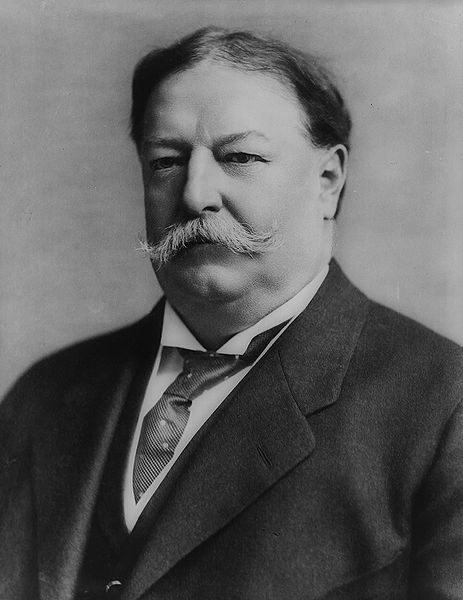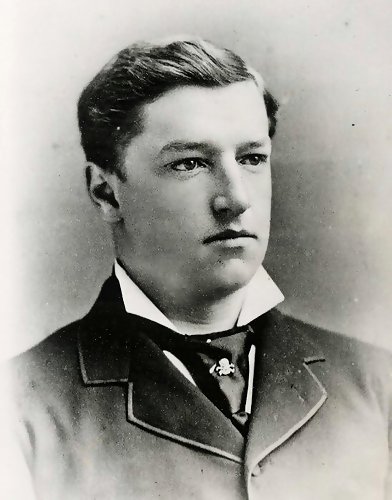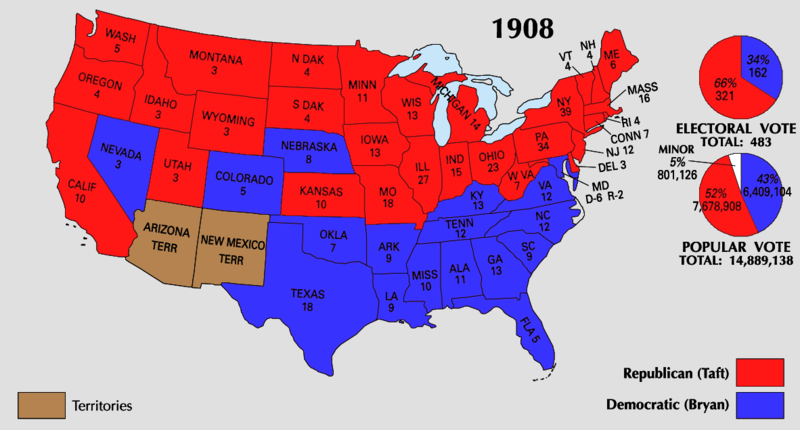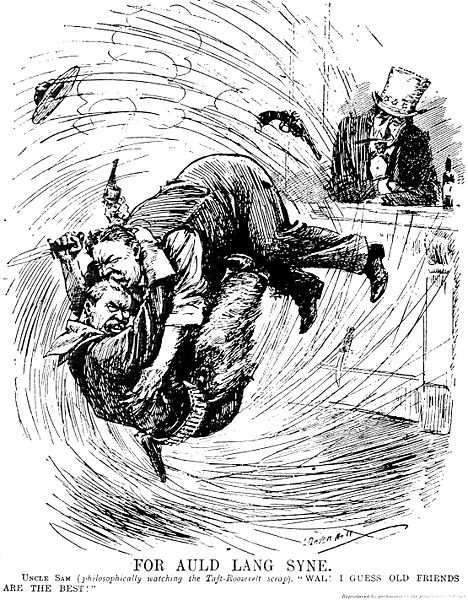| William Howard Taft | |
|---|---|
 |
|
| 27th United States President « Previous Next » |
|
| In office | Mar. 4, 1909 – Mar. 4, 1913 |
| V. President | James Sherman |
| Political Party | Republican |
| Personal Info | |
| Born | Sep. 15, 1857 |
| Died | Mar. 8, 1930 (at age 72) |
| Religion | Unitarianism |
| School | Yale University |
| University of Cincinnati | |
| Profession | Lawyer |
| Signature | |
| Wife | Helen Herron |
| Children | Robert Helen Charles |
| U.S. Presidents 26-35 | |
| 26. Theodore Roosevelt (1901-1909) | |
| 27. William H. Taft (1909-1913) | |
| 28. Woodrow Wilson (1913-1921) | |
| 29. Warren G. Harding (1921-1923) | |
| 30. Calvin Coolidge (1923-1929) | |
| 31. Herbert Hoover (1929-1933) | |
| 32. Franklin D. Roosevelt (1933-1945) | |
| 33. Harry S. Truman (1945-1953) | |
| 34. Dwight D. Eisenhower (1953-1961) | |
| 35. John F. Kennedy (1961-1963) | |
| List of All the Presidents |
William Howard Taft is known as the only person to have served both as a Chief Justice and as a President of the United States. He was born on the 15th of September 1857 in Cincinnati, Ohio.
His parents were both of British ancestry. His father, Alphonso Taft, came from Vermont to practice law in order to become a judge. Alphonso later became secretary of war and an attorney general of President Grant. William’s mother, Louise Torrey, came from Massachusetts.
Early Life
William studied at schools in Cincinnati and was found to be intelligent and a fast learner. He enrolled in Yale in the year 1874 and proved to become popular among various cliques. He graduated second in his batch in 1878 before returning to Cincinnati to attend law school. He was able to pass the bar exams in Ohio in 1880.
He was soon appointed as assistant prosecutor in the state’s Hamilton County a year later. Taft moved on to become the county’s collector of internal revenue, which proved short-lived as he soon moved on to become a private practitioner of law. Four years later he returned to Hamilton County to become an assistant on solicitors.
On the 19th of June 1886, Taft married his childhood sweetheart Helen “Nellie” Herron, a daughter of a high-profile lawyer. They had had three children, namely Robert Alphonso, Helen Herron, and Charles Phelps. Nellie was intelligent and determined to support her husband in his endeavors.
She played a significant role in Taft’s political career, especially when he was soon appointed by President Benjamin Harrison as the US solicitor general. This position did not last, however, when a year later he returned to Cincinnati to become a court judge for a span of eight years.
Chief Civil Administrator
 In 1900, Taft was sent to the Philippines by President McKinley to serve as the chief civil administrator. Having displayed an understanding for the Filipinos, he made it a point to contribute to the country’s economy by building schools and roads. He even allowed the people’s participation in government matters.
In 1900, Taft was sent to the Philippines by President McKinley to serve as the chief civil administrator. Having displayed an understanding for the Filipinos, he made it a point to contribute to the country’s economy by building schools and roads. He even allowed the people’s participation in government matters.
Taft soon became the Philippines’ first civil governor. As a leader, it was his intention to spread the importance of quality education. At that time the Philippines was still suffering from the trauma brought by the colonialism of the Spaniards and the Roman Catholic friars. Taft saw to it that any hint of their rule was put to an end by achieving an independent country free from land ownership of foreigners. With the help of the Vatican, he was able to sell the land back to the Filipinos.
A few years later when McKinley was assassinated, the presidency was taken over by Theodore Roosevelt, who twice offered Taft a position on the US Supreme Court. Taft declined both offers, saying that his work in the Philippines was yet to come to its conclusion.
Joining Theodore Roosevelt’s Cabinet
Taft had little knowledge that Roosevelt had already set his eyes on him as his ideal successor. The then-current president had ascertained his need for Taft to become part of his Cabinet. Both of them soon arrived to an understanding that Taft would still be able to continue supervising his work in the Philippines, which allowed him to accept the position as Secretary of War.
Taft was known for his ability to multitask. He was able to serve the US administration both at home and in the Philippines. He was able to oversee the construction of the Panama Canal between the year 1904 and 1908. He became one of Roosevelt’s most favorite emissaries, and the president felt confident whenever Taft was by his side.
Taft was offered a position in the Supreme Court in the year 1906. It was at this point when Roosevelt had announced that he would not run after the 1904  elections. A huge number of the ex-president’s supporters saw Taft as one of the best candidates to succeed the presidential seat. Even Roosevelt himself felt confident that his reforms would be continued once his favorite was elected. Taft decided to run for president.
elections. A huge number of the ex-president’s supporters saw Taft as one of the best candidates to succeed the presidential seat. Even Roosevelt himself felt confident that his reforms would be continued once his favorite was elected. Taft decided to run for president.
William Jennings Bryan proved to be an intimidating opponent, having served as president twice in the past. Taft’s campaign methods involve undercutting Bryan’s support on liberalism. Bryan, on the other hand, assigned an elitist image on his opponent. After a strong and vigorous campaign period, Taft won by a small margin. In 1908, he was elected president.
Life as President
It was his new set of policies that made his presidential term memorable to Americans. William introduced new controls over the budget as well as an 8-hour workday for all employees serving the government. He also made it a point to pass the campaign-spending disclosure bills, which punished a number of companies that bypassed the anti-trust laws.
He found himself at a serious disadvantage after realizing the amount of contributions Roosevelt had done while in office. People saw him more as a  judicial leader rather than a political one. He was often pointed out as a poor public speaker and a procrastinator. Soon there existed a falling out of trust between the two parties, with Roosevelt labeling Taft a huge disappointment and an incompetent individual controlled by important businesses. Taft would later on admit that he found his job overly intimidating.
judicial leader rather than a political one. He was often pointed out as a poor public speaker and a procrastinator. Soon there existed a falling out of trust between the two parties, with Roosevelt labeling Taft a huge disappointment and an incompetent individual controlled by important businesses. Taft would later on admit that he found his job overly intimidating.
In 1912 Roosevelt announced that he wanted the Republicans to nominate him as president. Taft, on the other hand, was resolute that his former friend would not succeed. At a 1912 convention he successfully stopped the organizers from giving important seats to a number of Roosevelt delegates. He acquired the Republican nomination afterwards. Roosevelt, desperate not to allow Taft to gain the seat of presidency for the second time, entered the Progressive Party, known as Bull Moose. The act managed to split the Republican votes. Taft’s past administration, however, proved ineffective to the voting masses, allowing his Democratic opponent Woodrow Wilson to win by a large margin.
Supreme Court Chief Justice
After losing the presidency, Taft worked as a Professor of Law in Yale. He spent his time writing articles for newspapers and books, most of which specialized in legal philosophy. He was also seen as an active advocate for world peace via international arbitration, which promoted the idea of a League of Nations. Years later, President Harding would make him Chief Justice of the US Supreme Court, a position which he found to be one of the most memorable he took in his entire life. In fact, he once wrote that he never even remembered becoming president. He held the position of Chief Justice until his death.
On the 3rd of February 1930 Taft retired from the position due to ill health. He died a few weeks later on March 8, 1930. He was the first president to be buried in Arlington National Cemetery and was the only Chief Justice to gain a state funeral.
Various tributes to Taft spread after that. Courthouses in Ohio were named after him. So did streets in Cincinnati, a school in California, and a major street in Manila, Philippines, where he worked his hardest as a politician. His family would soon enter politics. Robert Taft, Jr., his grandson, became a Senator in Ohio from 1971 to 1977. William Howard Taft III, meanwhile, became US ambassador to Ireland in 1953.